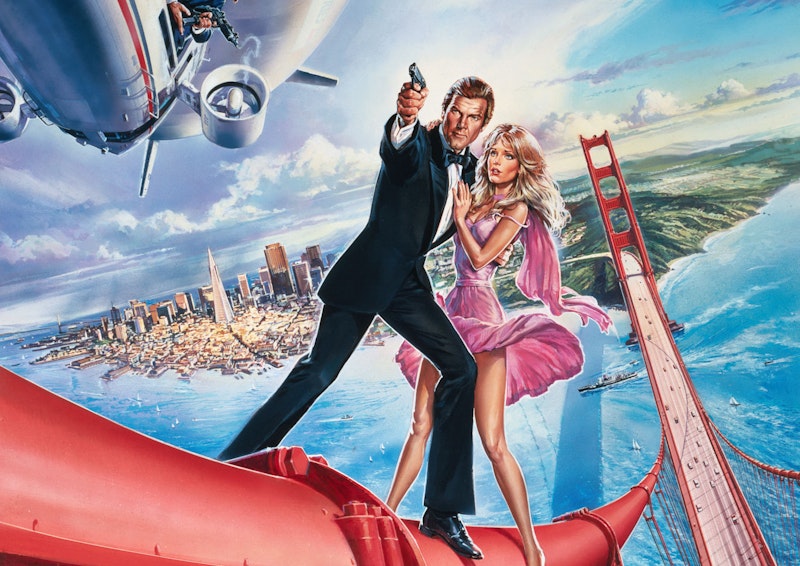A View to a Kill starts out badly. The 14th James Bond adventure from Eon Productions has a clunky opening sequence marred by an especially goofy use of the Beach Boys’ “California Girls” over what should have been thrilling action. David Lee Roth released a cover of the song four months before this movie came out, so this is less a callback to the 1960s than a jarring nod to the film’s present moment of 1985.
The sequence soon ends, and the movie becomes less painful and occasionally fun. It has no idea of its strengths and weaknesses, and how to go about being what it wants to be. Still, unlike the last couple of Eon Bond pictures, at least it has good ingredients.
Recovered a microchip from the dastardly Soviets, Bond’s sent to spy on the government contractor who made the chip, Max Zorin. After an escapade in Paris with a mysterious woman (Grace Jones) who the audience knows is Zorin’s bodyguard May Day, Bond and MI6 colleague Godfrey Tibbett (Patrick Macnee) go undercover at a horse sale at Zorin’s estate. Zorin easily sees through Bond’s cover, kills Tibbett, and nearly kills 007. The product of a Nazi eugenics program, Zorin was working with the KGB but split with them to pursue his own project: the destruction of Silicon Valley through geological sabotage in order to drive up the price of microchips. Bond trails him to San Francisco, teams up with a lovely geologist named Stacey Sutton (Tanya Roberts), and together they set out to thwart the baddies.
It’s another standard outing for the Eon Productions crew. John Glen turns in his usual uninspired directorial effort. Richard Maibaum again wrote the script, rewritten by Michael G. Wilson, who for the first time gets a credit as producer. Maurice Binder’s title sequence is unusually perfunctory, but it boasts the best theme song since 1963’s Goldfinger (with all due respect to Paul McCartney) thanks to Duran Duran.
And the first half of the film is carried by the chemistry of two pairs of actors. Moore and Macnee, longtime friends, play off each other with real humor and charm. Meanwhile, Walken and Jones are inspired casting choices who work well together. There’s a brief scene of them sparring, after which they share a smile, which turns into a mix of foreplay and threat display. Weirdly unlike most sexy scenes in the Bond canon, it’s a nice moment created out of almost nothing.
Unfortunately, Macnee’s character dies, the action shifts to the United States, and the plot slows down. An interlude with an old Russian flame of Bond’s (originally planned to be Agent XXX from The Spy Who Loved Me) is an interruption of the momentum, and Tanya Roberts is unable to sell her character as an intelligent highly-educated geologist. Moore remains too old for the part—he turned 57 during filming, and reportedly decided to give up the role when he found he was older than Roberts’ mother—and cuts from him to his stunt doubles are obvious.
There’s a good car chase, which is irrelevant to the plot, then after a nice sequence at a flooding mine the movie falls apart at the climax. That happens frequently in Glen’s Bond films because he doesn’t build a character arc for Bond (fair enough for an action-series hero), identify meaningful themes, or develop secondary characters. He can’t structure an ending beyond tying up narrative loose ends; it’s all just a bunch of stuff happening.
There’s nothing to do with Ian Fleming’s short story, “From A View to a Kill,” which saw Bond investigate a murder in France. Wilson told Starlog in 1985 that “for all practical purposes, we’ve been out of material for the past five films.” And thus this movie, nominally an original story, but which follows typical Bond formulas.
The plot’s about microchips, but the technology on display in the film’s often old-fashioned: reel-to-reel tapes, a blimp that ferries Zorin about over San Francisco. The movie knows it’s not aiming at realism, but doesn’t want to be a real bleeding-edge technothriller. Nor does it want to build the kind of fantastical world Bond adventured through in earlier films.
The Nazi eugenics in Zorin’s background is pulpy weirdness that fits a Bond movie, but the filmmakers don’t know what to do with it. Perhaps they don’t want to suggest any validity to a Nazi breeding program, but the idea of a champion of Western democracy overcoming a fascist ubermensch is strong (strong enough to have carried decades of Captain America comics). Yet here it’s so underexplored it’s never more than a pallid borrowing from the backstory of Khan in Star Trek II—just as Zorin’s plan recalls both Goldfinger and Superman: The Movie.
It's a movie of odd glints. That sparring scene. The exasperated faces of Patrick Macnee. Walken’s manic laugh as he machine-guns innocents (a moment that made Moore uncomfortable). A few jokes that land, including a moment when Bond makes quiche. (There was a 1980s book called Real Men Don’t Eat Quiche, which— look, you had to be there in 1985, but trust me, in context, the gag works.)
By this point the Bond movies have settled into a rhythm, producing subpar action movies every two years. This one has its moments, carried by some acting chemistry and a good theme song. But it’s an exercise in nostalgia. The scene with the female spy talking with Bond about old times is significant: the movie looks back to the old days, less a Bond film than an evocation of Bond films that were. Do you remember when James Bond movies were good? The people who made this movie do. They just can’t make a good one themselves.

